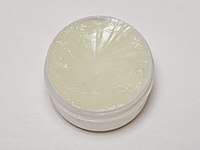
Photo from wikipedia
Background/ObjectivesThis historical control study examined the differences in the incidence of postoperative pneumonia between patients administered liquid and semi-solid nutrients after percutaneous endoscopic gastrostomy (PEG).Subjects/MethodsThe medical records of adult patients… Click to show full abstract
Background/ObjectivesThis historical control study examined the differences in the incidence of postoperative pneumonia between patients administered liquid and semi-solid nutrients after percutaneous endoscopic gastrostomy (PEG).Subjects/MethodsThe medical records of adult patients who underwent PEG between March 1999 and March 2014 were investigated. The patients were administered either liquid or semi-solid nutrient and examined for gastroesophageal reflux via radiography after PEG. The study period was divided into periods I (liquid nutrient to all patients), II (semi-solid nutrient to patients with reflux and liquid nutrient to those without), and III (semi-solid nutrient to all patients). The patient characteristics and incidence of postoperative pneumonia were stratified by the periods. To assess the relationship between postoperative pneumonia and the periods, a logistic regression analysis was performed.ResultsOf 370 patients enrolled, 149 were in period I, 64 in period II, and 157 in period III. Postoperative pneumonia was more frequently observed in period I (20.8%) than in periods II (7.8%) and III (10.2%). The odds ratios were higher in period I (period I vs. II: 3.10 [95% confidence intervals: 1.15–8.38]; period I vs. III: 2.32 [1.21–4.44]). The incidence of gastroesophageal reflux did not greatly differ between periods II (25.0%) and III (35.0%).ConclusionsThe incidence of postoperative pneumonia after PEG was lower in the patients administered semi-solid nutrient than in those administered liquid nutrient, suggesting that semi-solid nutrient administration to patients with PEG tubes is preferable to prevent postoperative pneumonia. Furthermore, it may be favored especially in those with gastroesophageal reflux.
Journal Title: European Journal of Clinical Nutrition
Year Published: 2019
Link to full text (if available)
Share on Social Media: Sign Up to like & get
recommendations!